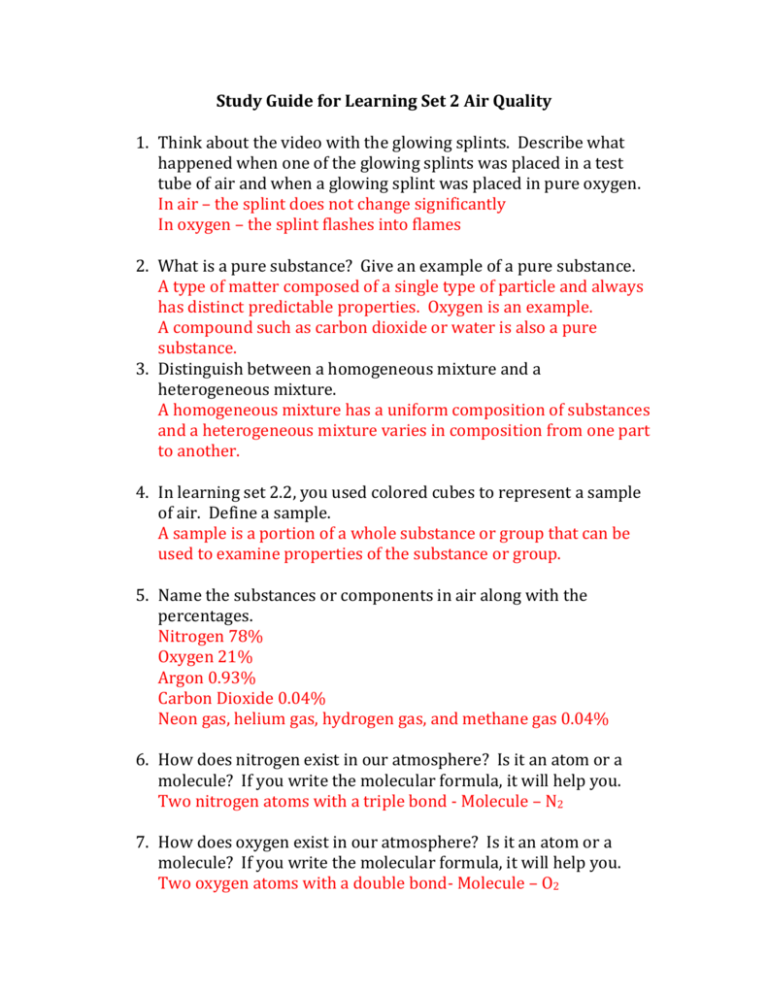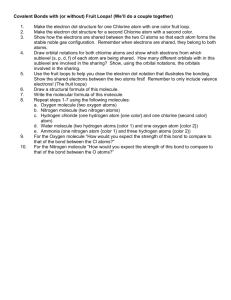Study Guide for Learning Set 2 Air Quality
advertisement

Study Guide for Learning Set 2 Air Quality 1. Think about the video with the glowing splints. Describe what happened when one of the glowing splints was placed in a test tube of air and when a glowing splint was placed in pure oxygen. In air – the splint does not change significantly In oxygen – the splint flashes into flames 2. What is a pure substance? Give an example of a pure substance. A type of matter composed of a single type of particle and always has distinct predictable properties. Oxygen is an example. A compound such as carbon dioxide or water is also a pure substance. 3. Distinguish between a homogeneous mixture and a heterogeneous mixture. A homogeneous mixture has a uniform composition of substances and a heterogeneous mixture varies in composition from one part to another. 4. In learning set 2.2, you used colored cubes to represent a sample of air. Define a sample. A sample is a portion of a whole substance or group that can be used to examine properties of the substance or group. 5. Name the substances or components in air along with the percentages. Nitrogen 78% Oxygen 21% Argon 0.93% Carbon Dioxide 0.04% Neon gas, helium gas, hydrogen gas, and methane gas 0.04% 6. How does nitrogen exist in our atmosphere? Is it an atom or a molecule? If you write the molecular formula, it will help you. Two nitrogen atoms with a triple bond - Molecule – N2 7. How does oxygen exist in our atmosphere? Is it an atom or a molecule? If you write the molecular formula, it will help you. Two oxygen atoms with a double bond- Molecule – O2 8. What is the difference between an atom, compound, and mixture? An atom is the basic building block of matter. A compound is a pure substance made up of two or more different elements. A mixture is two or more substances combined such that each substance may retain its own identity. 9. What are the reactants in the photosynthetic process or the process of photosynthesis? The equation for photosynthesis is: 6 H2O + 6 CO2 ---> C6H12O6 + 6 O2 Water + Carbon Dioxide 10. What are the products in the photosynthetic process or the process of photosynthesis? The equation for photosynthesis is: 6 H2O + 6 CO2 ---> C6H12O6 + 6 O2 Glucose + Oxygen 11. How does argon exist in nature? What other atoms will it combine with? Exists as single atoms. It does not form molecules. 12. Distinguish between the solvent and solute. Think of sugar dissolved in water. What is the sugar? What is the water? The solvent is the component of a solution present in the greatest amount and the solute is the component of a solution said to dissolve in the solvent. Sugar would be the solute and water would be the solvent. 13. How many total atoms are in the water molecule, H20? Explain how you got the total number of atoms. 2 atoms of hydrogen and 1 atom of oxygen, which would give a total of 3 atoms. 14. Think about the molecule building you did in learning set 2.4. How many chemical bonds are between the nitrogen atoms? oxygen atoms? Nitrogen has 3 bonds and oxygen has 2 bonds. 15. Does argon exist as an atom or a molecule? Explain. Think about the molecular formula. Exists as an atom since the formula is Ar. 16. Does nitrogen exist as an atom or a molecule? Explain. Think about the molecular formula. Two nitrogen atoms so it is a molecule - Molecule – N2. 17. Does carbon dioxide exist as an atom or a molecule? Explain. Think about the molecular formula. It exists as a molecule since it has more than 2 atoms – CO2. 18. Name the three subatomic particles in an atom. Protons, neutrons, and electrons 19. Which subatomic particle has the smallest mass? Electrons 20. Which subatomic particle determines an atom’s unique identity as a specific element? Proton 21. What subatomic particle is found inside the nucleus of an atom and is electronically neutral? Neutron 22. What subatomic particle is found inside the nucleus of an atom and has a positive charge? Proton 23. What happens when two protons move closer to each other? The force of repulsion increases the closer they move together. 24. Chlorine has 17 protons with an atomic mass of 35. a. What is the atomic number of chlorine? Explain your answer. 17 Same as the number of protons. b. How many neutrons does chlorine have? Explain your answer. 18 Neutrons + protons = atomic mass c. How many electrons does chlorine have? Explain your answer. 17 In a neutral atoms electrons equal the number of protons. 25. Distinguish between a group and a period on the Periodic Table. Each column represents a group or chemical family. The rows of the periodic table are periods. 26. Oxygen and sulfur are in the same group on the Periodic Table of the Elements. What do they have the same number of? Valence electrons 27. When you hung your index card with tape outside, what were you collecting? Particulate matter which is solid particles that become airborne and can be inhaled by people. 28. Define soot and which element makes up the majority of soot? Soot is particulate matter that is a product of combustion. Carbon 29. Distinguish between a product and a reactant in a chemical reaction. A reactant is a substance that enters into a chemical reaction and a product is a substance that is formed by a chemical reaction. 30. What are the products in a combustion reaction? Carbon dioxide, water , and soot







